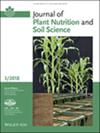Spectral and Textural Features for Predicting Soil Phosphorus Using Vis-NIR Point Data and Multispectral UAV Imagery: A Case Study From a Long-Term Experiment
Abstract
Background
Soil nutrient status assessment is a key aspect of crop management. Unlike the labor- and time-intensive conventional approach, precision farming techniques are expanding to ensure the uniformity of soil nutrients, enhance production, and alleviate economic pressure.
Aims
In this study, the potentials of visible and near-infrared spectroscopy (Vis-NIRS), as non-imaging technology and multispectral imagery mounted on unmanned aerial vehicle (UAV) to predict plant-available (AP) and total phosphorus (TP) (P) were studied and compared.
Materials & Methods
Soil samples were taken from a long-term experiment with contrasting fertilization treatments, and their spectra were recorded. Additionally, drone multispectral images were taken before and after soil tillage and seedbed preparation.
Results
The predicted available P content by Vis-NIRS was characterized by a cross-validation determination coefficient of R2cv = 0.82 and validation determination coefficient of R2v = 0.74, whereas the root mean square error for cross-validation (RMSEcv) and validation (RMSEv) were, respectively, 11.23 and 14.09 mg kg−1. The random forest (RF) model based on the textural and spectral features from multispectral images taken after seedbed preparation had the highest performances to predict plant-available P (R2v = 0.68, RMSEv = 13.65 mg kg−1, and RPIQv = 2.98), whereas the lowest prediction accuracy was obtained for total P prediction model after seedbed preparation (R2v = 0.40, RMSEv = 67.91, and RPIQv = 0.6). The effective wavelengths were around 450, 580, and 700 nm for predicting the available P fraction. Before soil tillage, the vegetation indices ranked high in the RF prediction models for available phosphorus (AP) and TP as compared to those developed after using tillage image-derived indices. In contrast, red-edge, red, and green bands, in addition to texture indices, were the most important predictors of soil available P following seedbed preparation.
Conclusion
Our study suggests that soil tillage and seedbed preparation incorporate vegetation cover and alter soil roughness, resulting in a more homogeneous, smoother surface and higher accuracy for soil P prediction using UAV multispectral imagery.

 求助内容:
求助内容: 应助结果提醒方式:
应助结果提醒方式:


